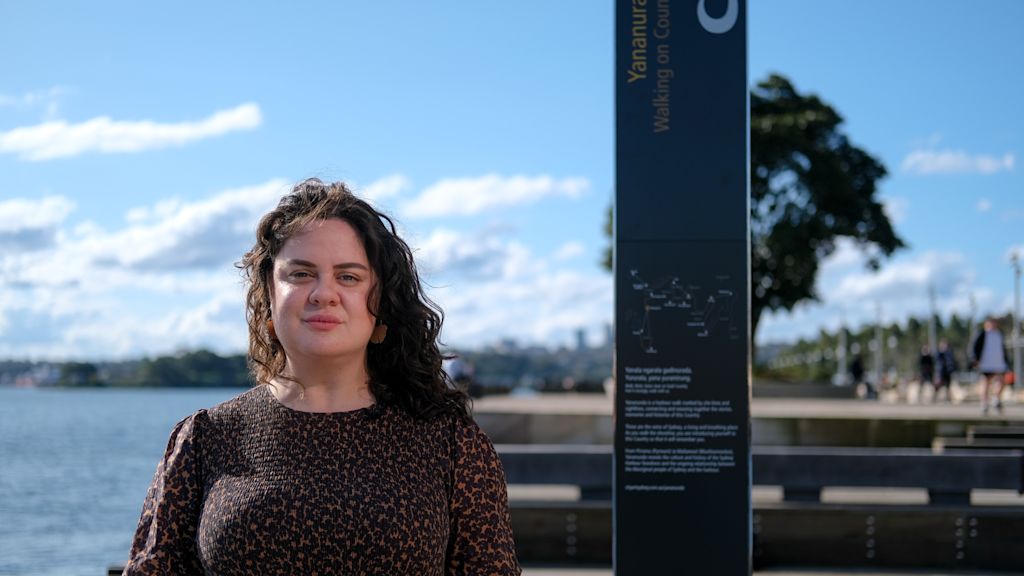Eleven interpretive markers highlighting historically significant Aboriginal people and places have been installed along the Sydney Harbour foreshore.
The signs are the first component of a 9-kilometre curated walk from Pirrama (Pyrmont) to Wallamool (Woolloomooloo) called Yananurala, a name from the Gadigal language that translates to walk Country.

A long-term project led by Indigenous curator Emily McDaniel, Yananurala is part of the Eora Journey: Recognition in the public domain program curated by Hetti Perkins and guided by the local Aboriginal community.
Yananurala will bring Aboriginal histories and stories to life through public artworks and installations along the foreshore route.
“Yananurala is a harbour walk that weaves together the stories, memories and histories of this Country. These are the veins of Sydney – a living and breathing place,” Emily McDaniel said.
“An Acknowledgement of Country in its truest form, Yananurala reveals the ongoing relationship between the Aboriginal people of Sydney and the harbour.”
Some of the people and places the walk highlights include:
- Tara (Dawes Point), where conversations between Patyegarang, a Gadigal woman, and Lieutenant William Dawes began. Dawes’ diaries have become central to the preservation of Aboriginal language in Sydney
- Barangaroo, a senior and influential Cammeraygal woman who first met British officers in 1790
- Memel (Goat Island), an island historically attributed to Bennelong’s custodianship. Bennelong was a Wangal man remembered as an influential conduit between the British and the Eora in the early days of the colony. The island is visible from the Barangaroo headland, an area named after Bennelong’s wife. Today, the connection highlights the story of a couple renowned for their differing opinions and actions in relation to the British colony
- the Gadigal women who fished from nawi (canoes) in harbour waters at Pirrama (Pyrmont)
- the Aboriginal people who worked on the wharves at The Hungry Mile, a section of Barangaroo
- how the expansion of Sydney in the 1800s forced Aboriginal people to camp at the derelict Boatshed. People living there were relocated to La Perouse, the first Aboriginal reserve in Sydney.
“Yananurala continues our commitment to Aboriginal people that began in 2007 to ensure First Nations people, cultures and heritage are recognised in the city’s public spaces,” Lord Mayor Clover Moore said.
“Carefully and respectfully realising Aboriginal stories through art and interpretation, Yananurala highlights the way Aboriginal and Torres Strait Islander people know and experience Country.
“We’re grateful for the advice and support of the Metropolitan Local Aboriginal Land Council and the City of Sydney Aboriginal and Torres Strait Islander Advisory Panel. The project has brought together NSW Government agencies and cultural institutions to work in collaboration and partnership to develop this project.”
“I love Yananurala. The cultural walk along the foreshore will bring our local stories and our local artists to interpret and strengthen our connection to the harbour, land and sky. This is a great opportunity for our community and the many talented artists we have here in Sydney,” Daniel Coe, member of the City of Sydney Aboriginal and Torres Strait Islander Advisory Panel, said.
Walkers can follow the route and find out more about each site using the Yananurala map on the City of Sydney’s Culture Walks app.
In future, installations and artworks highlighting hidden harbour histories and relationships between places of cultural significance will be located along the foreshore walk.
Aboriginal and Torres Strait Islander artists and designers are currently invited to put forward proposals for the Sitelines and Conversations project, a series of audio and text installations that thread together and build on the stories highlighted on the walk’s newly installed signs. Submissions close 11am Tuesday 22 November.
A major artwork to recognise the young Aboriginal woman Patyegarang, who taught Lieutenant William Dawes Sydney Aboriginal language, is planned for Tara (Dawes Point).
The artwork could take many forms and the brief will be developed with the City of Sydney Aboriginal and Torres Strait Islander Advisory Panel, Metropolitan Local Aboriginal Land Council, Aboriginal community members and the NSW Government. We are commencing consultation with community to guide the development of this project.
Yananurala is the fifth project in the City of Sydney’s Eora Journey program to recognise First Nations cultures and heritage in the public domain.
A major new monument inspired by shell fishing hooks handcrafted and used by local Aboriginal women for generations, bara, by Judy Watson, was unveiled in May.
Find out more about the walk at cityartsydney.com.au/yananurala
Visit sydneybarani.com.au for more on the Aboriginal history of Sydney.
For media enquiries or images, contact Roxanne Macara.
Phone 0438 554 640 or email rmacara@cityofsydney.nsw.gov.au
For interviews with Lord Mayor Clover Moore contact Zoe Delamare.
Phone 0477 263 615 or email ZDelamare@cityofsydney.nsw.gov.au
